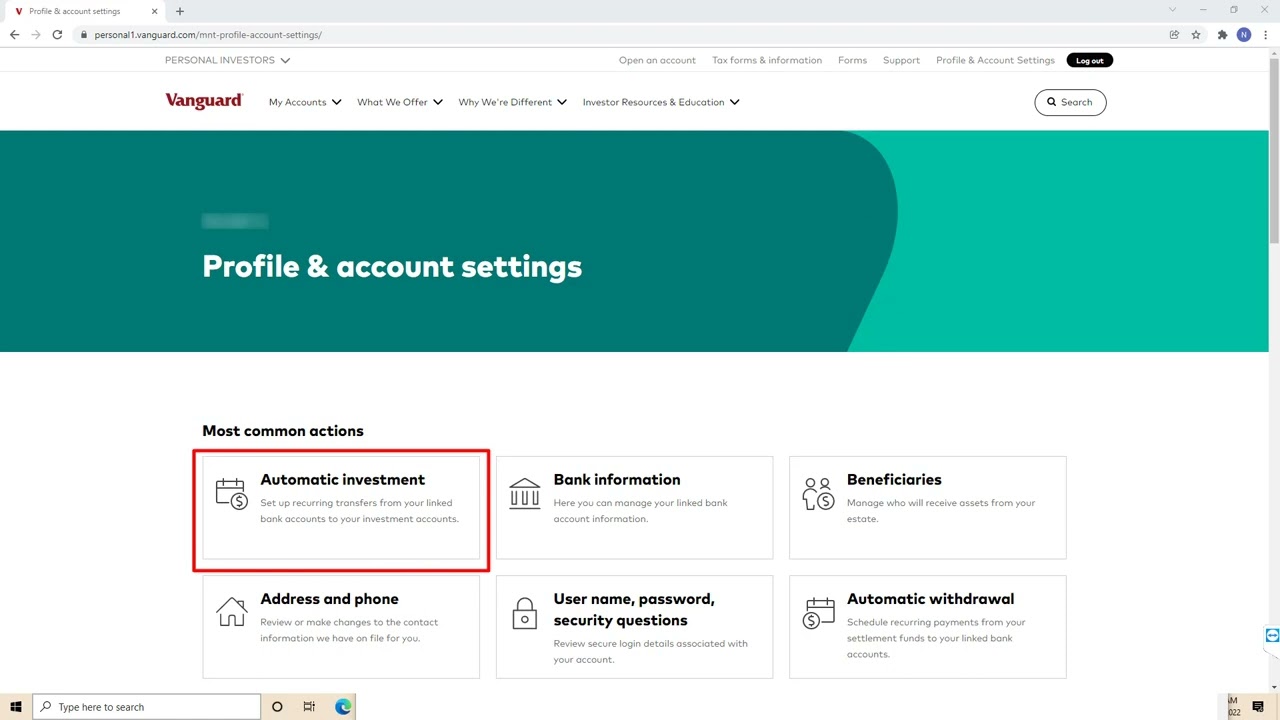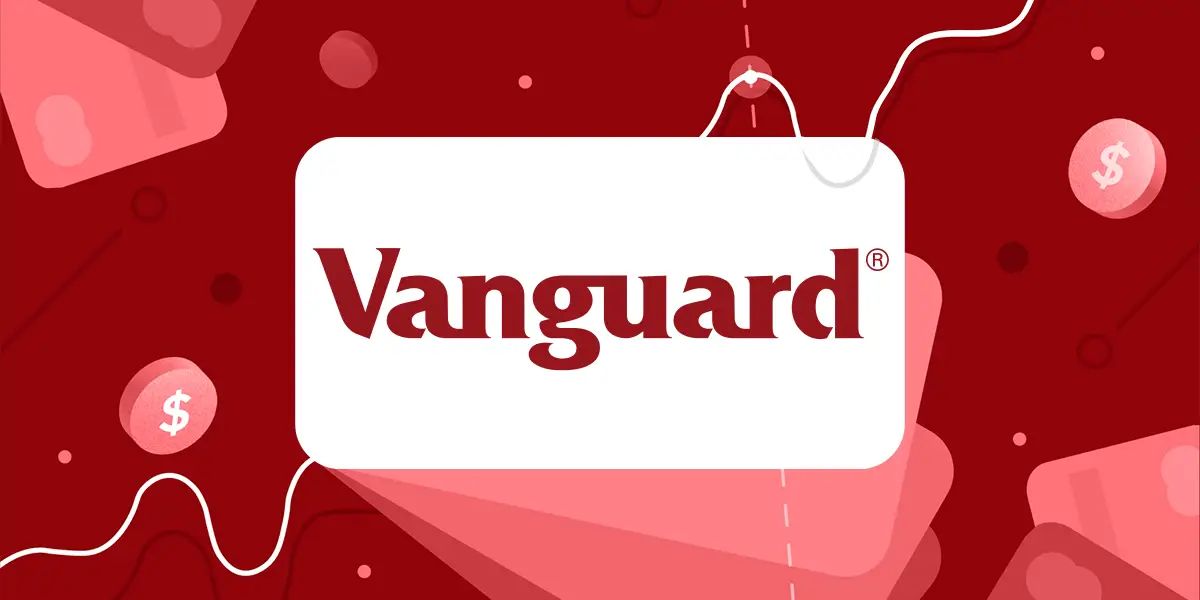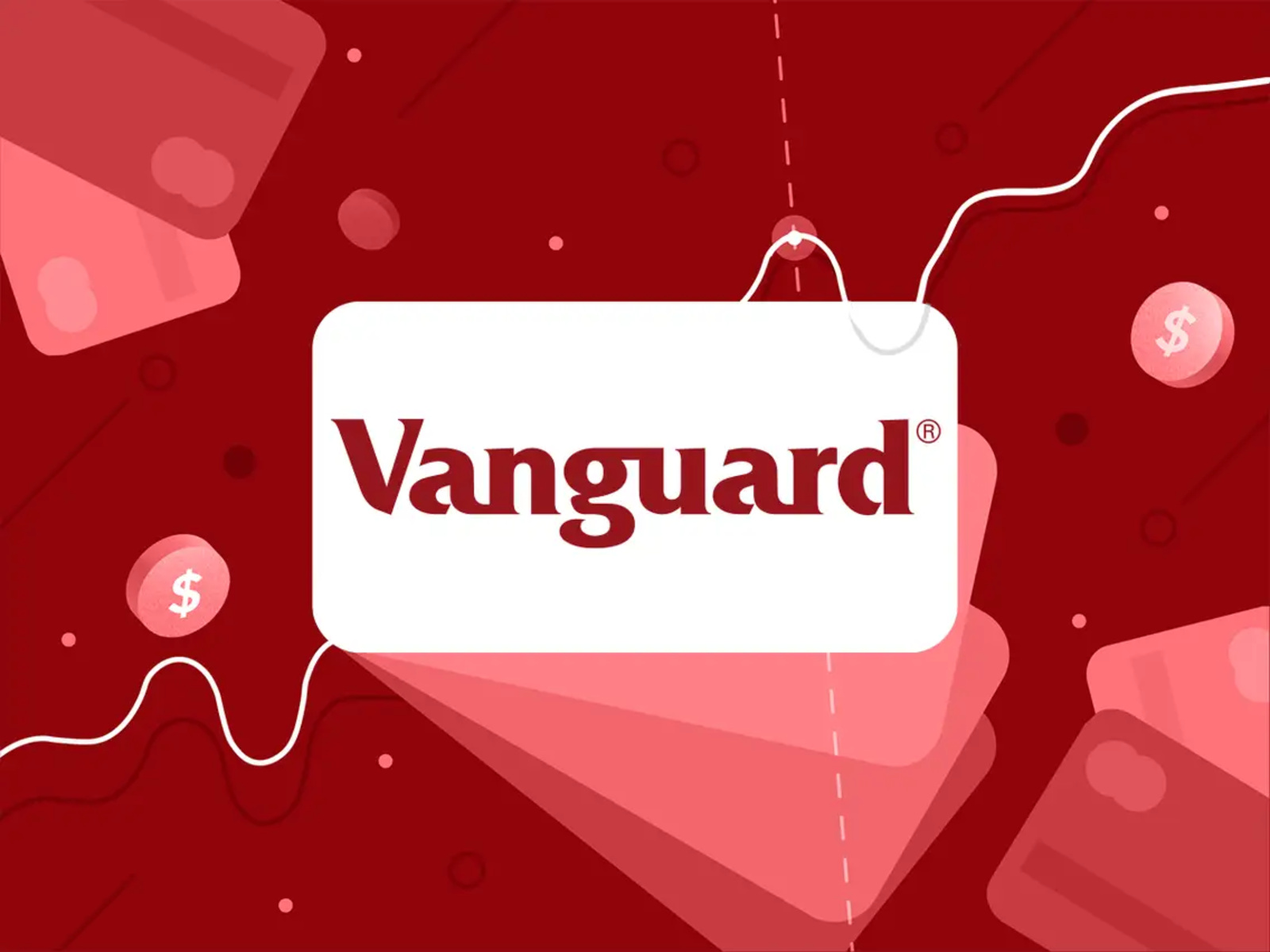Introduction
Welcome to our guide on how to set up automatic investments with Vanguard. Investing is a powerful way to grow your wealth over time, and Vanguard is renowned for its low-cost investment options and stellar reputation in the financial industry. By setting up automatic investments, you can make consistent contributions to your investment portfolio without the need for constant manual intervention.
Automatic investments are a convenient and disciplined approach to building your investment portfolio. With automatic investments, you can set up recurring contributions from your bank account to be allocated to your chosen investment funds at regular intervals, such as weekly, bi-weekly, or monthly. This hands-off approach ensures that you stay on track with your investment objectives and take advantage of the power of compounding.
Vanguard, one of the world’s largest investment management companies, offers a wide range of investment options, from mutual funds to exchange-traded funds (ETFs). The company is known for its diversified investment options, low expense ratios, and long-term performance. By utilizing Vanguard for your automatic investments, you can benefit from their expertise and access a broad range of investment opportunities.
In this guide, we will walk you through the step-by-step process of setting up automatic investments with Vanguard. Whether you are a seasoned investor or just starting, this guide will provide you with the information you need to take advantage of automatic investing and grow your wealth over time.
What are Automatic Investments?
Automatic investments, also known as dollar-cost averaging or recurring investments, involve setting up a system whereby a fixed amount of money is invested at regular intervals into specific investment vehicles. Instead of making lump sum investments, automatic investments allow individuals to contribute small, consistent amounts over time.
This strategy offers several advantages. First, it eliminates the need for timing the market and trying to predict the best time to invest. By investing regularly, you take advantage of the inherent volatility of the market, allowing you to buy more shares when prices are low and fewer shares when prices are high. This approach, known as “buying the dips,” can potentially lead to lower average costs over the long term.
Second, automatic investments promote financial discipline. By automating your investment contributions, you remove the temptation to spend the money elsewhere. The consistent contributions also help develop a regular saving and investing habit, allowing you to build wealth over time.
Furthermore, automatic investments can help mitigate the impact of market fluctuations on your overall investment portfolio. When the market is experiencing volatility, it can be difficult to determine the best time to invest. However, with automatic investments, you invest a fixed amount at regular intervals, allowing you to potentially take advantage of volatility by buying more shares when prices are depressed.
Automatic investments are particularly effective for long-term investors looking to build wealth or save for retirement. By consistently investing over a prolonged period, individuals can benefit from the compounding effect of their investment returns. Over time, the growth potential of compounded returns can be significant.
It’s important to note that automatic investments do not guarantee profits or protect against losses. As with any investment, there are risks involved, including the potential for loss of principal. It’s essential to carefully consider your investment objectives, risk tolerance, and consult with a financial advisor before setting up automatic investments.
Why use Vanguard for Automatic Investments?
When it comes to automatic investing, Vanguard is a top choice for many investors. Here are several compelling reasons why you should consider using Vanguard for your automatic investments:
- Low Cost: Vanguard is known for its low-cost investment options, with expense ratios that are typically lower than the industry average. By minimizing costs, more of your investment dollars can be put to work in the market, potentially boosting your overall returns in the long run.
- Diversified Investment Options: Vanguard offers a wide range of investment options, including mutual funds and exchange-traded funds (ETFs), covering various asset classes and investment strategies. This allows you to build a diversified portfolio tailored to your investment objectives and risk tolerance.
- Proven Track Record: Vanguard has a long-standing history of delivering consistent and competitive investment performance. The company’s focus on index funds and passive investing has consistently generated solid returns for investors over the years.
- Financial Stability: Vanguard is known for its financial stability and solid reputation in the financial industry. The company operates as a client-owned organization, meaning it is owned by its funds, which are in turn owned by the investors. This unique structure aligns Vanguard’s interests with its investors and emphasizes the company’s commitment to their long-term success.
- Robust Customer Service: Vanguard is renowned for its exceptional customer service. Whether you have questions about your automatic investments, need assistance with account management, or require investment guidance, Vanguard’s knowledgeable and friendly customer service team is available to help you every step of the way.
With these advantages, Vanguard has earned the trust and loyalty of millions of investors worldwide. By opting for Vanguard as your provider for automatic investments, you can benefit from their low costs, diversified investment options, excellent track record, financial stability, and outstanding customer service.
It’s important to note that while Vanguard offers numerous benefits, it’s essential to consider your personal investment goals, risk tolerance, and consult with a financial advisor to determine if Vanguard is the right choice for your specific needs.
Steps to Set Up Automatic Investments with Vanguard
Setting up automatic investments with Vanguard is a straightforward process. Follow these step-by-step instructions to get started:
- Create a Vanguard Account: If you don’t already have one, visit the Vanguard website and create a new account. The process typically involves providing personal information, setting up login credentials, and agreeing to the terms and conditions. It’s important to have all necessary identification and financial details handy.
- Link Your Bank Account: Once you have a Vanguard account, you’ll need to link it to your bank account. This allows for seamless transfers of funds for the automatic investments. Follow the provided instructions on the Vanguard website to securely link your bank account. Ensure that you have your bank account information, including the routing number and account number.
- Determine Your Investment Amount: Decide how much you want to invest automatically. You can choose a fixed dollar amount or a percentage of your income. Consider your financial situation, goals, and risk tolerance when determining the amount. Vanguard typically has minimum investment requirements for each fund, so make sure you meet those criteria.
- Choose Your Investment Fund(s): Select the investment fund(s) you want to contribute to with your automatic investments. Vanguard offers a wide range of funds, including index funds and actively managed funds. Consider your investment objectives, time horizon, and risk tolerance when choosing your funds. You can diversify your investments by selecting multiple funds.
- Set Up Automatic Investments: Access your Vanguard account and navigate to the “Automatic Investments” section. Follow the instructions provided to set up the automatic investment plan. You will need to specify the frequency (e.g., weekly, bi-weekly, monthly), the start date, and the investment amount. You can also choose how long you want the automatic investments to continue.
- Review and Confirm: Before finalizing your automatic investment plan, thoroughly review the details to ensure accuracy. Check the investment amount, frequency, chosen funds, and start date. Once you are satisfied, confirm your choices and complete the setup process. Vanguard may require additional authentication steps to protect your account.
Once you have completed these steps, your automatic investment plan with Vanguard will be set up. The predetermined amount will be automatically deducted from your linked bank account at the specified frequency and invested in your chosen funds.
It’s important to regularly monitor your automatic investments and review your investment portfolio to ensure it aligns with your goals. You can make changes or adjustments to your automated plan as needed to reflect changes in your financial situation or investment strategy.
By following these steps and regularly reviewing your automatic investments, you can set yourself up for long-term financial success and take advantage of Vanguard’s renowned investment opportunities.
Step 1: Create a Vanguard Account
The first step in setting up automatic investments with Vanguard is to create an account. Follow these steps to get started:
- Visit the Vanguard Website: Go to the official Vanguard website [www.vanguard.com] in your web browser.
- Click on “Open an Account”: Look for the “Open an Account” button or link on the homepage. Click on it to proceed.
- Choose the Account Type: Vanguard offers different types of accounts, including individual accounts, joint accounts, retirement accounts (such as Traditional IRA, Roth IRA, or 401(k) rollovers), and custodial accounts. Select the account type that suits your needs and investment goals.
- Provide Personal Information: Fill out the required information, such as your name, address, date of birth, Social Security number, and employment details. Vanguard follows strict security protocols to protect your personal information.
- Create Login Credentials: Choose a username, password, and security questions. Make sure to select a strong password that includes a combination of letters, numbers, and special characters.
- Review and Agree to Terms: Carefully review the terms and conditions, privacy policy, and any other required agreements. Ensure that you understand and agree to all the terms before proceeding.
- Verify Your Identity: Vanguard may require you to verify your identity for security purposes. This can be done by answering security questions or providing additional identification documents.
- Submit Your Application: Once you have filled out all the necessary information and reviewed everything, submit your application. Vanguard will process your application, usually within a few business days.
Once your Vanguard account application is approved, you will receive confirmation via email with instructions on how to log in to your new account. Take note of your login credentials and keep them in a secure place.
Creating a Vanguard account is the first step toward setting up automatic investments. Having an account allows you to access a range of investment options and manage your investments conveniently online. It also gives you access to Vanguard’s additional services, such as financial planning tools and educational resources, to help you make informed investment decisions.
Now that you have successfully created a Vanguard account, you can proceed to the next step of setting up automatic investments by linking your bank account.
Step 2: Link Your Bank Account
Once you have created a Vanguard account, the next step in setting up automatic investments is to link your bank account. This allows for easy and seamless transfers of funds for your investments. Follow these steps to link your bank account:
- Login to Your Vanguard Account: Visit the Vanguard website and log in using your username and password that you created during the account registration process.
- Access the Account Management Section: Once logged in, locate and click on the “Account Management” or “Profile” tab. This is typically found in the navigation menu at the top of the page.
- Find the “Banking & Trading” Section: Within the account management section, look for the “Banking & Trading” or “Linked Accounts” subsection. Click on it to proceed.
- Add Your Bank Account: In the banking and trading section, you will find an option to link a bank account. Click on the link or button that allows you to add a bank account.
- Enter Bank Account Details: Fill out the required information, including your bank’s name, routing number, and account number. This information can typically be found on your checks or by contacting your bank directly.
- Verify Your Bank Account: Vanguard will initiate a verification process to ensure the accuracy and ownership of the bank account. This may involve confirming small deposits made to your bank account or linking your Vanguard account with your existing bank account.
- Confirm the Link: Once your bank account is successfully linked and verified, confirm the link within your Vanguard account settings. This step ensures that the linked bank account is ready to be used for automatic investments.
By linking your bank account to your Vanguard account, you can easily transfer funds for your automatic investments. Vanguard prioritizes the security and privacy of your financial information, and their website is equipped with robust encryption and security measures to protect your data.
It’s important to note that Vanguard may have specific requirements or restrictions when it comes to linking bank accounts. Ensure that you comply with their guidelines and provide accurate information to avoid any delays or complications in setting up your automatic investments.
Now that your bank account is successfully linked to your Vanguard account, you are ready to move on to the next step of determining your investment amount.
Step 3: Determine Your Investment Amount
After linking your bank account with Vanguard, the next step in setting up automatic investments is to determine the amount you want to invest. This decision will depend on your financial goals, risk tolerance, and available funds. Follow these steps to determine your investment amount:
- Evaluate Your Financial Situation: Take a close look at your overall financial situation, including your income, expenses, and savings. Consider your budget and determine how much you can comfortably allocate towards investments on a regular basis.
- Establish Your Investment Goals: Clarify your investment goals and time horizon. Are you investing for a short-term goal, such as a down payment on a house, or are you saving for retirement? Understanding your goals will help you determine the appropriate investment amount.
- Consider Your Risk Tolerance: Assess your risk tolerance, or how comfortable you are with potential fluctuations in the value of your investments. If you have a higher risk tolerance, you might be willing to invest a larger amount. If you have a lower risk tolerance, you may prefer to start with a smaller investment amount.
- Review Fund Minimums: Vanguard typically has minimum investment requirements for each fund. Ensure that the amount you choose meets or exceeds these minimums. This information can usually be found on the Vanguard website or by speaking with a Vanguard representative.
- Choose a Fixed Amount or Percentage: Decide whether you want to invest a fixed dollar amount or a percentage of your income. Some investors prefer a fixed amount to maintain consistency, while others opt for a percentage to adjust the investment amount relative to their income changes.
- Consider Automatic Increases: Determine if you want to set up automatic increases in your investment amount over time. This can help your investments keep pace with inflation and your evolving financial circumstances.
Remember that the investment amount you choose for automatic investments can be adjusted in the future if needed. It’s important to start with an amount that you are comfortable with and can sustain over the long term.
By carefully evaluating your financial situation, considering your investment goals and risk tolerance, and reviewing any fund minimums, you can determine the appropriate investment amount for your automatic investments with Vanguard. This step sets the foundation for building your investment portfolio and working towards your financial objectives.
Step 4: Choose Your Investment Fund(s)
Once you have determined your investment amount, the next step in setting up automatic investments with Vanguard is to choose the investment fund(s) that align with your financial goals and risk tolerance. Here’s what you need to do:
- Evaluate Your Investment Objectives: Consider your investment goals, whether they are long-term growth, income generation, or a combination of both. Vanguard offers a wide range of funds with different investment objectives, including index funds, actively managed funds, bond funds, and sector-specific funds.
- Assess Your Risk Tolerance: Determine your risk tolerance, or how comfortable you are with the potential fluctuations in the value of your investments. Vanguard provides tools and resources to help you assess your risk tolerance and understand the level of risk associated with different investment options.
- Research Vanguard Funds: Explore the various fund options available on the Vanguard website. Take advantage of the detailed information provided for each fund, including historical performance, expense ratios, holdings, investment approach, and risk factors.
- Diversify Your Portfolio: Consider diversifying your portfolio by selecting a mix of funds that align with different asset classes, such as stocks, bonds, and international investments. Diversification can help spread risk and potentially enhance returns over the long term.
- Consider Target Date Retirement Funds: If you are investing for retirement, Vanguard offers Target Date Retirement Funds, which automatically adjust the asset allocation based on your intended retirement date. These funds provide a convenient “set it and forget it” option for investors.
- Review Fund Performance and Fees: Evaluate the historical performance of the funds you are interested in, along with the associated fees and expenses. Vanguard is known for its low-cost investment options, so take a close look at the expense ratios to ensure they align with your investment goals.
Remember, choosing the right investment funds is crucial to the success of your investment portfolio. It’s important to assess your investment objectives, risk tolerance, and perform thorough research before making your selections.
If you are uncertain about which funds to choose, Vanguard offers tools, resources, and even personalized advice to help you make informed investment decisions. Additionally, consulting with a financial advisor can provide valuable guidance based on your specific financial situation and goals.
Once you have carefully chosen your investment fund(s), you are ready to move on to the next step of setting up automatic investments with Vanguard: actually initiating the automated investment process.
Step 5: Set Up Automatic Investments
Now that you have determined your investment amount and chosen your investment fund(s), you are ready to set up automatic investments with Vanguard. Follow these steps to initiate the automated investment process:
- Login to Your Vanguard Account: Visit the Vanguard website and log in using your username and password.
- Navigate to the Automatic Investment Section: Once logged in, locate the “Automatic Investment” or “Recurring Contributions” section within your Vanguard account. This is typically found in the account management or investment selection area.
- Select Your Investment Account: If you have multiple accounts with Vanguard, choose the investment account that aligns with the automatic investment plan you want to set up. This could be an individual brokerage account, an IRA, or any other eligible account type.
- Specify the Investment Details: Provide the necessary information for the automatic investment plan. This includes the investment amount, frequency (e.g., weekly, bi-weekly, monthly), and start date. Some plans may also allow you to specify an end date or continue until you manually stop the automatic investments.
- Choose the Investment Fund(s): Select the investment fund(s) you want to contribute to with your automatic investments. You can choose from the funds you researched and selected earlier. Ensure that the allocation matches your portfolio diversification goals and risk tolerance.
- Review and Confirm: Thoroughly review the details of your automatic investment plan. Double-check the investment amount, frequency, chosen funds, and start date to ensure accuracy. Once you are satisfied with the details, click the “Confirm” or “Submit” button to finalize the setup.
After confirming your automatic investment plan, Vanguard will automatically deduct the specified investment amount from your linked bank account at the selected frequency and invest it into the chosen funds. You can view the progress and details of your automatic investments within your Vanguard account.
It’s important to regularly review and monitor your automatic investment plan to ensure it aligns with your financial goals and make any adjustments as needed. You can modify or cancel the plan, adjust the investment amount, or change the allocation of funds at any time through your Vanguard account.
By setting up automatic investments with Vanguard, you are taking a proactive step towards achieving your financial goals while taking advantage of Vanguard’s renowned investment options and low-cost funds.
Step 6: Review and Confirm
The final step in setting up automatic investments with Vanguard is to review and confirm the details of your automatic investment plan. This critical step ensures that everything is accurate and aligned with your investment goals. Follow these steps to review and confirm your plan:
- Login to Your Vanguard Account: Visit the Vanguard website and log in to your account using your username and password.
- Access Your Automatic Investment Plan: Once logged in, navigate to the section of your Vanguard account where you set up your automatic investment plan. This may be referred to as the “Automatic Investment” or “Recurring Contributions” section.
- Review the Plan Details: Carefully review the specifics of your automatic investment plan. Ensure that the investment amount, frequency, chosen funds, and start date are all correct. Also, confirm that the plan aligns with your investment objectives and risk tolerance.
- Check Your Bank Account Link: Confirm that your bank account is properly linked to your Vanguard account. Double-check the routing number and account number to ensure they are accurate. This ensures smooth and error-free transactions for your automatic investments.
- Verify the Funding Source: Ensure that the correct bank account is selected as the source of funds for your automatic investments. If you have multiple bank accounts linked, make sure you select the desired one for the transactions.
- Consider Modifying the Plan: If any adjustments or changes need to be made to your automatic investment plan, such as modifying the investment amount or adding additional funds, make the necessary modifications at this stage.
- Confirm and Finalize: Once you have thoroughly reviewed the plan details and made any necessary adjustments, click on the “Confirm” or “Submit” button to finalize your automatic investment plan. Vanguard may require additional authentication steps to protect your account.
After confirming your automatic investment plan, Vanguard will execute the transactions according to the specified investment amount and frequency, automatically deducting the funds from your linked bank account and investing them into the chosen funds.
It’s essential to periodically monitor your automatic investment plan and review your overall investment portfolio to ensure it remains aligned with your goals. You can make changes or adjustments to your plan as needed to accommodate any changes in your financial circumstances or evolving investment strategy.
By carefully reviewing and confirming your automatic investment plan, you can have peace of mind knowing that your investments are set up correctly and are actively working towards your long-term financial objectives.
Conclusion
Setting up automatic investments with Vanguard is a smart and convenient way to grow your wealth over time. By following the steps outlined in this guide, you can seamlessly establish an automated investment plan that aligns with your financial goals and risk tolerance.
Automatic investments offer numerous benefits, including removing the need for market timing, promoting financial discipline, and mitigating the impact of market fluctuations. Vanguard, with its low-cost investment options, diversified funds, proven track record, financial stability, and exceptional customer service, is an ideal choice for implementing automatic investments.
In this guide, we discussed the steps involved in setting up automatic investments with Vanguard. First, you need to create a Vanguard account, followed by linking your bank account to facilitate efficient transfers. Next, you determined your investment amount, chose the appropriate investment fund(s) based on your goals and risk tolerance, and set up the automatic investments in your Vanguard account.
Remember to regularly review and monitor your automatic investment plan to ensure it remains aligned with your financial objectives. You can make adjustments or modifications to your plan as needed to accommodate changes in your financial circumstances or investment strategy.
Investing is a long-term endeavor, and Vanguard provides a wealth of resources and support to help you make informed investment decisions. Their low-cost investment options and reliable track record make Vanguard an excellent choice for automatic investments.
By automating your contributions and harnessing the power of compounding, you can steadily grow your wealth and work towards your financial aspirations. Start setting up your automatic investments with Vanguard today and take a proactive step towards a brighter financial future.

























